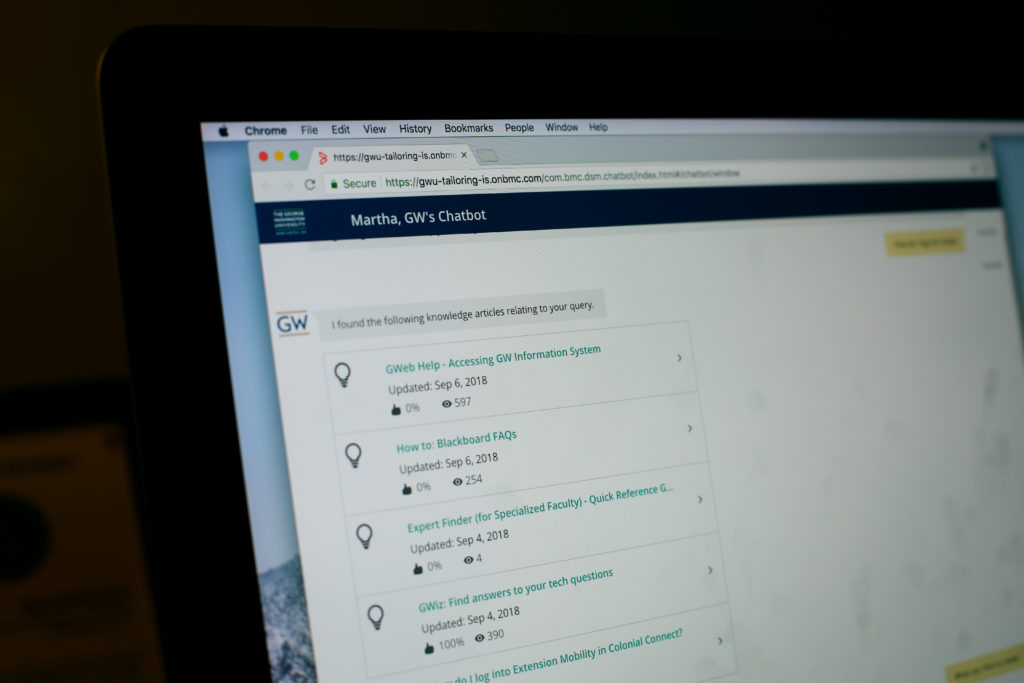Instead of picking up the phone or walking to the IT Support Center, students can now get their technology glitches fixed through an instant messaging robot.
GW is the first of its peer schools to pilot a chatbot designed to help answer students’ questions about technological issues. Artificial intelligence experts said chatbots are increasingly being used to improve the efficiency of university offices by answering questions that would otherwise take up paid staff members’ time.
Officials announced in an email to students last week that community members can test out the new chatbot, MARTHA, during a monthlong pilot period and fill out a survey to help administrators decide if the robot would be “valuable” to the University. The end of the pilot period is Sept. 30, according to the email.
On the test page, students can ask the bot questions about GW’s information technology services, like how to reset passwords or how to register devices on GWplay, the University’s streaming and gaming network. Students can also text the chatbot after registering their phones with the system, according to the email.
“Your support and feedback about MARTHA will help determine whether this tool can be expanded to include other GW topics and rolled out to the larger university community,” the email states.
If the pilot period is a success, officials will determine how to expand MARTHA’s capabilities to answer more service-related inquiries, according to the frequently asked questions page.
The robot can be run on Mac and Windows computers, as well as on mobile phones with Internet Explorer, Safari, Firefox or Google Chrome, according to the FAQ page.
University spokeswoman Maralee Csellar said staff at the Division of Information Technology spent approximately 200 hours configuring and training the robot. She said the chatbot builds on the technology associated with the Digital Workplace, which launched in the spring as a central location for IT requests. The system is based on IBM’s Watson, a supercomputer system, she said.
“By implementing the virtual agent pilot, it is our hope that the students will attain even greater access to the technology services GW has to offer,” she said.
Using the feedback from students, staff will adjust the setup of the robot software to get the most accurate answers to students, Csellar said. She added that the bot will not have access to any sensitive information.
“The chatbot has a lot more potential than can be captured in the pilot, but with student input, it can continue to grow in functionality and capability and learn to provide information that far exceeds the technology focus it has in pilot form,” she said.
Artificial intelligence experts said the chatbots at universities are becoming more common as AI capabilities grow. They said the bots will help answer repetitive questions about the University that would otherwise detract from employees’ daily responsibilities.
Mary Francis Coryell, the vice president of business development at the chatbot development company Ivy, said university chatbots started becoming more popular in about 2016. Sixty universities currently use Ivy’s services in various departments, including financial aid and registrar offices, she said.
“People during business hours can do more value-added responsibilities,” she said.
Robots are most effective at answering simple questions that are repeatedly asked by students, Coryell said. With IT, robots can easily answer simple questions about Wi-Fi or login information, especially late at night when staffers would not be in their offices, she said.
Several universities nationwide have turned to chatbots to facilitate admissions processes or streamline student interactions in recent years. At Georgia State University, the admissions office uses the bot “Pounce” to answer questions about applications, EdTech reported in March.
Creighton University also offers a chatbot named “Iggy” that can answer questions about technology issues and campus-related information.
Ehsan Hoque, a professor of computer science at the University of Rochester, said that ultimately, a robot best functions as a complement to employees’ work. He said that some questions – especially those concerning sensitive topics, like mental health – are better answered by a person, but robots can take on more straightforward tasks.
He added that chatbots could also lessen face-to-face encounters between students and employees, which could hinder the development of interpersonal skills.
“The more I have a chatbot, the less opportunity I have to connect with the people next door and have a chat,” he said.
Hoque said chatbot use at universities is just taking off, but officials nationwide are hopping onto the trend because of the money-saving opportunities the robots offer. He said schools should not see virtual assistants as a way to get rid of jobs, but rather as a way to support the universities’ weakest services.
“I think we need to design the chatbot in such a way that it empowers the existing services and employees, allow them to do a better job,” he said.




